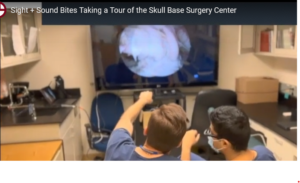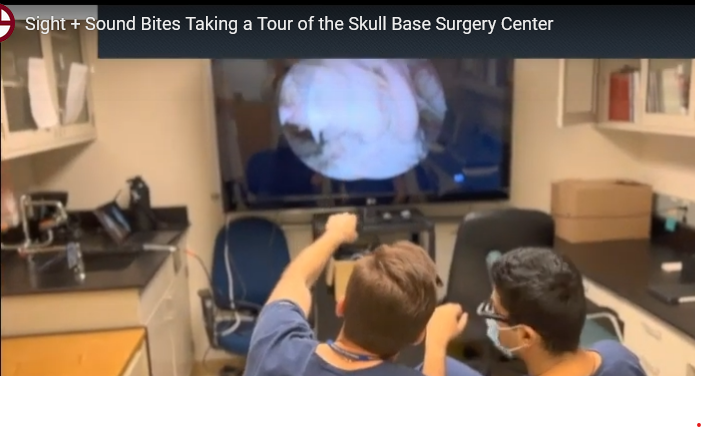On Monday, January 10, Eye & Ear Foundation webinar attendees got a tour of the University of Pittsburgh Skull Base Surgery Center from the comfort of their homes and offices.
Doctors Carl Snyderman (Professor of Otolaryngology, Otolaryngology Co-Director of the Center for Cranial Base Surgery) and Paul Gardner (Peter J. Jannetta Endowed Chair in Neurosurgery, Neurosurgical Co-Director of the Center for Cranial Base Surgery) said their goal was to share what the team was doing in the hopes that viewers would gain more insight into the efforts and resources required for their research.
The UPMC Center for Cranial Base Surgery is staffed by Doctors Snyderman, Gardner, Eric Wang, and Georgios Zenonos.
Skull Base Tumor Research
 Viewers were shown a lab working on molecular genetics hoping to identify genetic keys to tumors and novel treatments to test in the lab and eventually in clinical trials. This lab is also studying what these rare tumors require for growth. By understanding the metabolism of tumor cells or how their genes are altered, drugs that are clinically proven for other tumor types can be repurposed to treat these tumors.
Viewers were shown a lab working on molecular genetics hoping to identify genetic keys to tumors and novel treatments to test in the lab and eventually in clinical trials. This lab is also studying what these rare tumors require for growth. By understanding the metabolism of tumor cells or how their genes are altered, drugs that are clinically proven for other tumor types can be repurposed to treat these tumors.
Since less than four percent of the federal budget for cancer research is dedicated to childhood cancer, the lab depends a lot on philanthropic endeavors and donations. Too much time can be spent working on funding rather than being in the lab.
NeuroAnatomy Skills Lab
This lab has been open for almost 20 years and has played a key role in developing entirely new surgical approaches. Digital software is used to recreate 3D anatomic models which are used for research, teaching, education, and publication, reaching well beyond the lab.
In the high-definition fiber tracking lab, advanced MRI technology is used to understand how the different nerves, neurons and fibers in the brain are coursing around or through tumors, so surgeons can plan surgical approaches that avoid damaging them when operating.
NeuroCognitive Research
This research seeks to better understand the impact of tumors on higher brain function. Most physicians do not actually study complex cognition or “executive” function. The department of neurosurgery has two neuropsychologists, led by Dr. Luke Henry, whose job is to get a broad-based assessment of all brain circuits (memory, concentration, decision making, motivation, etc.) to get an idea of how a patient is affected before surgery and how the surgery or radiation therapy may affect function.
Patients are put through a battery of tests to assess their functioning. Dr. Henry showed one patient’s example of a test which involves copying a complex geometric image; the patient showed significant disorganization and degrading of function prior to surgery. There was a noticeable difference between that image, and one drawn after surgery where this function had dramatically improved.
Research
One of the challenges with skull base surgery is the diversity of conditions. There are at least 30 different tumor types, each with its own unique behavior and treatment. One of the most important aspects of improving patient care is better understanding of different tumor behaviors. Even though UPMC attracts patients from all over, any one institution may not have enough of these rare tumor types to answer basic questions regarding biologic behavior or best therapies. This requires collaboration with other institutions so that larger amounts of tissue or information can be gathered.
As the Director of Research, Benita Valappil talked about tissue and specimen collection. There is a significant amount of cost involved in collecting and analyzing these tissues.
A tumor registry documents all clinical data collected on patients, as well as “banking” of tumor tissue for research. Data can be accessed to target different research projects and multiple universities contribute samples in hopes of finding treatments and cures.
Patient Video
A patient named David shared his story of being diagnosed with sinonasal undifferentiated carcinoma. He has had two surgeries and is presently on a treatment plan of chemo and immunotherapy. He has been impressed with how informed Dr. Wang is about his type of cancer and has great confidence in him and his team.
“We’re fortunate to be considered world leaders in management of these difficult tumors,” Dr. Wang said.
These are very rare diseases and even a single center has a hard time accumulating enough information to provide meaningful results. By partnering with other leading universities to study quality of life, outcomes from cancers, and provide a robust tumor bank for next generation sequencing will help physicians understand challenges and molecular changes. It is an expensive process and is not largely sponsored by government agencies.
Predicting Tumor Behavior
Something the Center is excited about is the development of a molecular prognostication panel for chordomas, a cancer found in the bone at the base of the skull. For the longest time, they had no idea how to differentiate these tumors, from the more benign to the more aggressive. This panel – which was recently presented, published, and the recipient of an award – will lead to individualized care and help create treatment guidelines.
Direct Application to Patient
Dr. Gardner talked to a young patient about her experience. Her tumor was completely removed endoscopically; based on the new results from the molecular prognostication panel, she did not need the standard treatment of radiation afterward. Dr. Gardner said it was rewarding to be able to develop these surgeries and research, and as a result, watch patients like her grow up without the side effects of additional therapy.
Educational Online Community
Dr. Snyderman introduced Joanna, who runs a free educational skull base website. They have been working with the website since 2016. It recently moved to a new platform and has only continued to grow with almost 2,000 members. The website is free, global, and available 24/7, offering everything in the niche world of skull base. Case examples and anatomy seem to garner the most interest.
Most members to the site are from the U.S., which includes visiting scholars from overseas. Other countries in the top 10 with members are India, China, Brazil, Israel, Taiwan, Japan, Canada, Italy, and Mexico.
New Devices & Instruments for Surgery
Dr. Snyderman and two engineering students demonstrated an invention they developed. They came up with an innovation for the breathing tube used to put down the throat of people in surgery or on a ventilator in an ICU. Using green dye, they showed how the standard tubing with a balloon cuff at the end leaks more fluid compared to their version with soft flexible baffles.
One of the problems with breathing tubes in the throat is that secretions in the throat can drip into lungs and cause pneumonia, Dr. Snyderman explained. This has a 30 percent or more mortality rate. During COVID, with the increased number of patients on ventilators, even if they survived COVID, they often died of other pneumonias.
“This is just one example of how we work with engineering students at Pitt to develop their ideas and create new medical technologies,” Dr. Snyderman said.
Patient Quality of Life
One of the greatest investments of time has been clinical trials, Dr. Wang said. But unfortunately, they are often not supported by government funds even though they are very important to patients.
Dr. Snyderman reiterated that it is a team effort with lots of people working behind the scenes collaboratively to advance knowledge.
Q & A
Dr. Gardner gave credit to the neuropsychologist and department for ensuring that they can be part of the research process, as it is the next level of neurosurgical care. “We only understand maybe 10 percent of the brain function,” he said. “Not that we don’t use the other 90 percent. We don’t fully understand it. One of the first steps is testing it in order to study it. This is an entirely new frontier.”
Data collection is probably the most important need of the skull base program, from the patient’s perspective, Dr. Snyderman said. This is a labor-intensive process. Most institutions do not have the time and personnel to collect this data. On the training side of things, there is a need to understand how surgeons can do their job more effectively.
Dr. Snyderman is very proud of the legacy of Pittsburgh in skull base surgery. It is a pioneering center and preeminent in the world for doing this kind of work. It started back in the 1970s with Doctors Joseph Maroon and Eugene Myers, who performed the first modern skull base surgery at the University of Pittsburgh Medical Center and were the nucleus for putting together the center.
There have been two major paradigm shifts: the first was developing a big open skull base approach where the face and skull is taken apart to reach tumors. With the introduction of the endoscope in the late 1980s, surgeons can now work through the nose, avoiding the morbidity of open approaches. The University of Pittsburgh pioneered these techniques and recently pioneered a new approach through the sinuses to reach the brain for treatment of temporal lobe epilepsy.
Dr. Snyderman elaborated on surgical cognition. Some people are naturally good surgeons while others struggle. It can take years to become a master surgeon. He is establishing a unique center that studies visual cognition in surgery. “Pitt will be at the forefront for developing the best training and teaching methods,” he said.
